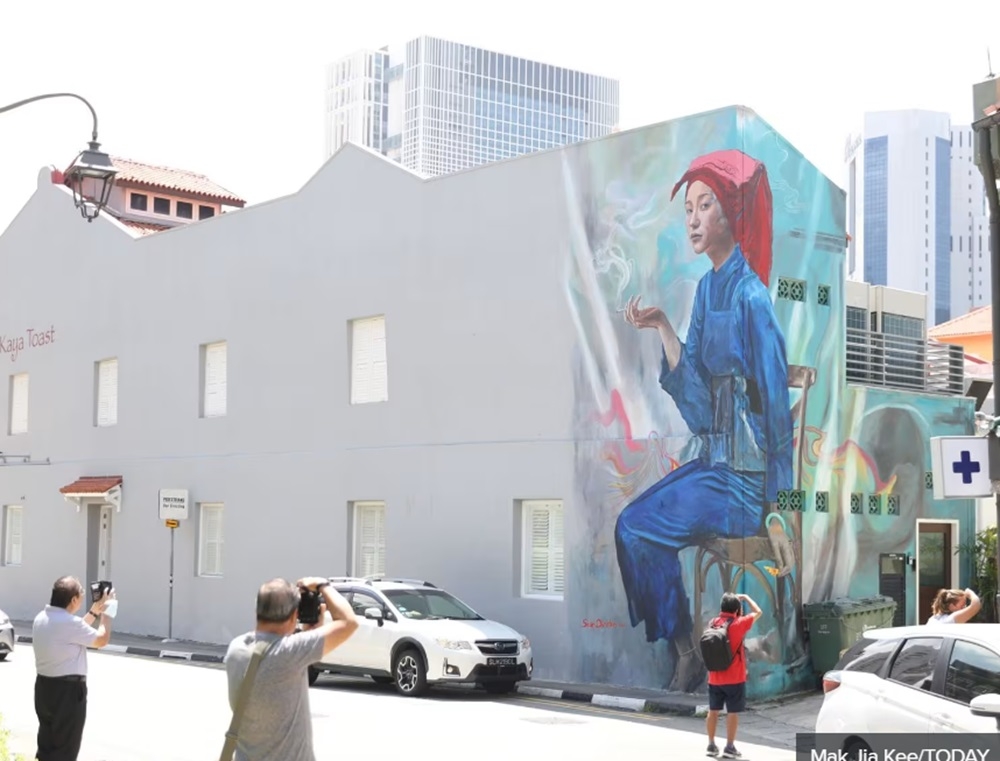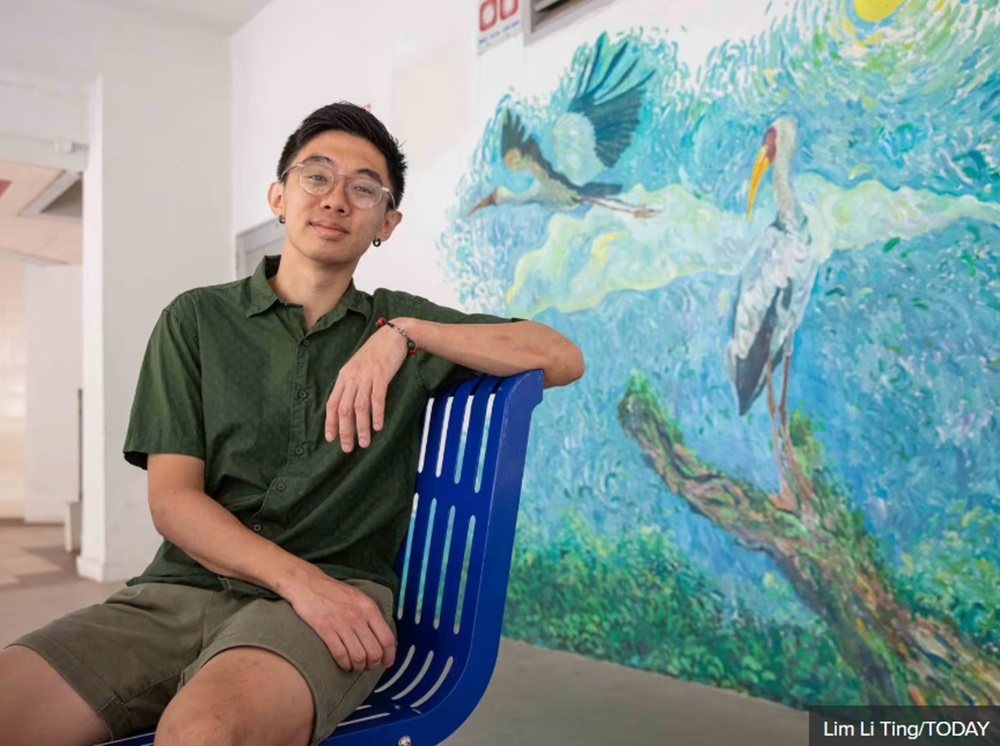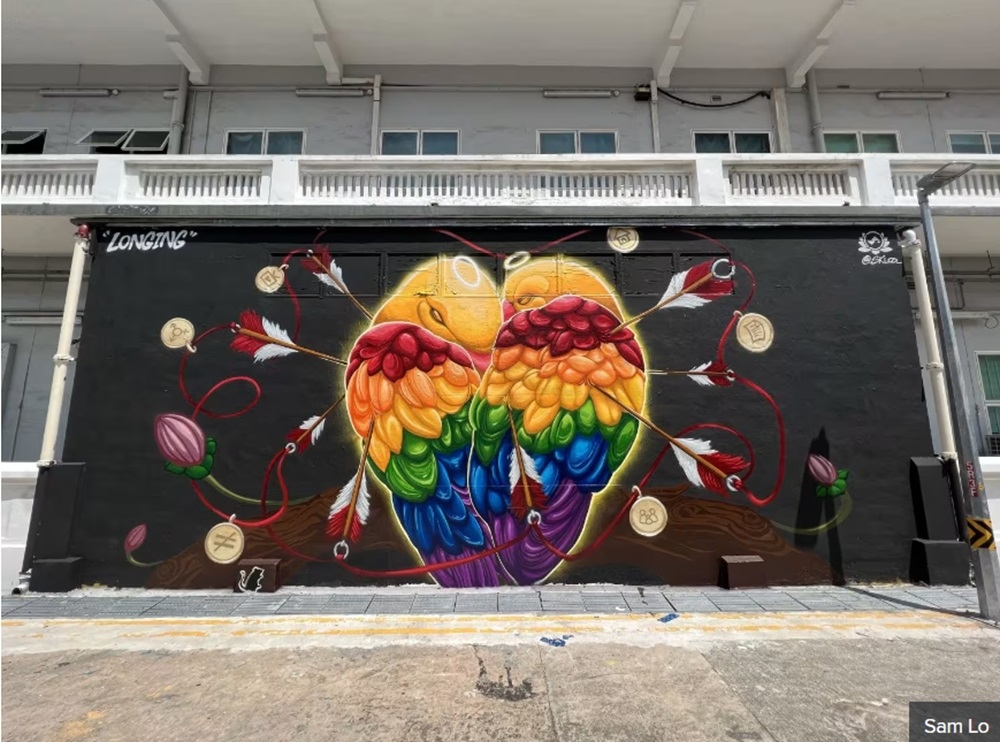- From “whitewashing” to bad weather, mural artists in Singapore often have to put up with challenges so that their work can see the light of day
- Public murals are in the spotlight after the Urban Redevelopment Authority ordered an artist to remove an image of a cigarette from a mural
- The artwork in Chinatown depicts a young samsui woman smoking
- Artists told TODAY about the numerous difficulties they have to navigate, including working from height and being mindful of how their work is perceived
- However, they are willing to weather these obstacles because of the impact their art has on the community
SINGAPORE, July 1 — When mural artist Belinda Low, 66, first found out that what she had painted for a cafe would be removed because the owner had moved to a new location, she was gutted.
It was particularly heart-wrenching because it was Low’s first cafe-commissioned work that she completed back in 2016, and she had laboured over two days to complete it.
A full-time administrator at a multinational company, Low likened the feeling of her art disappearing, often without her knowledge, to losing a baby.
Over the years, similar incidents have occurred with commissioned works for commercial spaces and housing blocks, where either a change of hands or upgrading works have caused her artwork to vanish.
Emotions aside, the veteran who has done public murals for nearly 11 years said: “Once we are paid for (an art piece), it belongs to them. I have to let it go.”
This is part and parcel of being a mural artist in Singapore, she added.
These artists have to reconcile with the impermanence of their work, after labouring for days — often under the hot sun and inclement weather — to produce paintings that are meant to be enjoyed by all.
Public murals have been in the spotlight recently. Earlier this month, the Urban Redevelopment Authority (URA) sent an order to an artist to erase a cigarette from a mural in Chinatown following a complaint by a member of the public. It sparked public outcry over the censorship of public art, and the URA is re-evaluating its stance.
The mural, painted by artist Sean Dunston outside a shophouse at 297 South Bridge Road, portrays a young samsui woman holding a cigarette in her hand.
In an Instagram post on June 19, Dunston said URA had informed him that someone had complained about his work, stating that the person found the mural “offensive” and “disrespectful” to samsui women.
The person also said that the woman looked more like a “prostitute” rather than a “hardworking samsui woman”.
Samsui women, who wore a trademark red head gear, were immigrants from China who worked as manual labourers usually at construction sites when Singapore was still a British colony in the early 20th century.

Against the backdrop of the Chinatown mural that has made the headlines, artists in this field said that it is common for their work to sometimes receive negative feedback from the public as well as from clients who commissioned the work.
At times, it could lead to “whitewashing”, which is the practice of covering up or erasing existing murals by painting over them with white or another neutral colour.
With the buzz surrounding murals here, TODAY spoke to five visual artists who have also painted murals to understand what it takes to paint in public spaces, how they handle clients’ whims, and the role of public art in Singapore.
Fleeting nature of public murals
Visual artist Toby Tan, who is better known by his artist moniker “tobyato”, said that he is not saddened when his artwork needs to be painted over or removed. This is because, ultimately, the artwork belongs to those who paid for it.
Still, the 29-year-old appreciates it when owners of his art would give him a “heads up” if, for whatever reason, his artwork needed to be painted over or removed.
He cited a recent example when the organisers and curators of Somerset Skate Park reached out to him to let him know that a large floor mural he did four years ago would be removed.
“People enjoyed the artwork. They skated on it, used it, and I hope they enjoyed it,” Tan said.
His mural, which was also created in collaboration with Singaporean skateboarder Faris Rahman, features two large skaters performing tricks and was inspired by the strong sense of support and camaraderie within the skating community.
“Any work doesn’t last forever; an exhibition ends, a public sculpture might get moved, a commissioned project launches and ends,” he added.
The removal of murals can happen due to a range of reasons, with several incidents making headlines in recent years.
Earlier this year, a dragon mural at Tampines North public housing estate was taken down by a cleaner just two days after it was put up.
This mural, created using removable white vinyl stickers, was intended to celebrate Chinese New Year but was deemed to have breached the by-laws of town councils, which oversee the maintenance of public housing estates.
Last year, a robot mural by artist Sonny Liew along Punggol Waterway was painted over after the authorities told him that the mural’s colours had deteriorated and faded.
In 2019, a mural by artist Zul Othman raised eyebrows due to its depiction of the 19th-century serial killer Wak Cantuk’s murderous rampage from Malay folklore. The subject matter drew criticism for its disturbing and insensitive nature and the mural was later removed.
The Malay Heritage Centre had commissioned the mural, which was painted on a long wall surrounding Gedung Kuning (Yellow Mansion).
Copious sunblock and painting from a height
Most of the visual artists who spoke to TODAY are no strangers to creating paintings in a studio.
However, for public murals, which are often larger in scale and outdoors, there are greater challenges since the artist must contend with the heat and manoeuvre around scaffolding.
Jacky Mak, 30, a painter whose art leans towards French impressionism and often features nature elements, said: “It is extremely physical.
“It’s one thing to paint on a large canvas where you’re seated in an air-conditioned room, but when it’s a huge wall, you often have to be on a ladder.”

Even when it is indoors, painting murals can be physically demanding, the artists said.
For a mural on the ceiling of Diptyque’s store in Ion Orchard mall, Mak had to sit cross-legged on a scaffold, contorting his body and craning his neck at an awkward angle to paint.
“My neck was very sore, and at some point, it kind of became injured just because I had to keep staring at the ceiling,” he said.
Painting a mural is a “balancing act” after all, he added.
“You have to try to express yourself creatively on a wall while also trying not to think about falling down when you are perched precariously on ladders.”
Visual artist Danielle Tay, 34, also recounted how she would have to assume various awkward positions to paint or draw, doing so while bearing the weight of a harness and multiple cans of paint.
“I paint intensively for eight hours a day, typically for a minimum of two weeks or more depending on the size of the mural, requiring stamina as I work in various positions,” Tay said.
For Low, who has a fear of heights, one of her most challenging murals was an ocean-themed one on Jurong Island that spanned over three storeys, which she completed in 2018.
To do so, she remembered having to undergo a course to learn how to use a harness on the scaffold and safety training to ensure that there were no accidents.
Another mural that she painted at Tekka Centre in Little India required her to scale a long ladder that was placed on uneven ground, which meant that she had to confront her phobia for the sake of her art.
Other artists such as Sam Lo, 37, recalled having to be suspended on ropes to paint the facade of a five-storey building.
“We had to make sure that whatever area we could cover on each trip down the rope was painted with little to no edits needed.
“Otherwise, we would need to climb up and down the ropes, which required a lot of physical exertion, or we had to set up the ropes all over again,” the urban artist said.
Being strung up at great heights is one thing, the artists also have to contend with the extreme heat from the sun, sometimes without any shade.
Tan recently completed a 90m collaborative mural with fellow artist Yip Yew Chong at Clarke Quay.
“It was the largest continuous mural for both of us, so naturally, it had a lot of physical demands,” Tan said.
“We managed the heat by draping wet towels over our heads inside our helmets, copious amounts of sunblock and multiple bottles of water at the ready.”
Mak said that some people might think painting at night is a smart way to avoid extreme sun, but for that to happen, the artist would have to be provided with industrial-level lighting at night to ensure that they can see the colours — an option that might not always be available.
A heavy downpour, on the other hand, would also make the paint “bleed” and ruin the mural, which is why artists often check multiple weather applications to monitor for sudden changes in weather.
“I assess whether it makes sense to wait for the rain to stop and the wall to dry before resuming work. If the downpour is heavy and it’s late in the day, I call it a day and use the time to recharge,” Tay said.
When visions don’t align
Since most of their work is commissioned, artists are often at the mercy of what their clients want, making it tough to manage expectations.
Low remembers a recent commission in April, where she had to paint a mural of the late founding prime minister Lee Kuan Yew along Buffalo Road in Little India to commemorate his visit to Tekka Centre there in 2010.
When she arrived at the site, she realised that she needed to paint nearly 17 life-sized figures when she had at first planned for only 10.
Low, who said that this was not usually her practice, added: “You cannot tell until you’re there, and I had to edit the draft (I sent to the client) a few times.
“It’s okay, after all, they are still the client. But I did hint to them that the quoted price includes the time spent planning for the mural as well.”
Lo said that when it comes to certain subject matters such as those related to the lesbian, gay, bisexual, transgender and queer (LGBTQ) individuals, he takes care to be more mindful about how he depicts them.
“I try to play in the grey areas by adding in Easter eggs, or in some cases like my pride murals, I just paint them because I believe they’re needed for the community to feel visible.”
Fully self-funded, Lo created his LGBTQ-themed pride murals last year, one of which is located at the back of the Aliwal Arts Centre near Beach Road. The mural depicts a pair of lovebirds huddling together as arrows strike them.
“Each arrow is tied to a red rope adorned with medallions representing the various hurdles queer couples face in Singapore as they strive to live whole lives,” he added.
The mural is no longer there because the space is constantly refreshed, but Lo said that it was up for about five to six months at the time.

While some pushback might come from clients, Tan said that he encountered this kind of feedback a little differently when he painted his first basketball court mural in 2019, which has since been removed.
This was his final-year project for university and he made it a point to heavily involve the residents and community.
He did online surveys, sat in during their resident network meetings to pitch his ideas, and held focus-group discussions to gather feedback from users of the space.
He soon realised that fulfilling everyone’s wishes was a lot of work, especially since there were so many parties involved.
“Some residents with apartments facing the court were even concerned about their unit’s selling price in future should I not do a good job.”
Despite the obstacles, the residents and the authorities were largely supportive of his idea, and they were generally very receptive to the final artwork he created.
The basketball court in Punggol was painted in vibrant shades of blue, honouring its status as Singapore’s first waterfront town.
Tan incorporated stick patterns on parts of the court, reflecting one of the meanings of “punggol” in Malay, which refers to the act of throwing sticks at fruit trees.
The role of public art
Art has traditionally been viewed as a privilege for the wealthy “who can buy art pieces”, but the power of public art lies in its ability to democratise creativity and make it accessible to a broader audience, Mak said.
Because of this impact that their art has on the community, these artists are willing to brave harsh weather conditions and unreasonable client requests to create their murals.
Mak said: “I feel like everyone should get to enjoy things like art and music. Community art is the best way I can help to achieve that.”
Besides beautifying the community, Low said that her art serves to showcase a way of life and even memorialise those who have died.
She gave an example of one of her murals in Holland Village, which featured a real-life person who lived there. After he died, Low said that his family would often visit the mural to remember him.
To other artists such as Tay, public art plays a vital role in the community by fostering a sense of identity, sparking dialogue and enhancing the visual landscape.
“It serves as a catalyst for community engagement, bringing people together to appreciate and reflect on shared spaces and experiences.”
Tan said that murals help to give a place “more character and charm,” and if his artwork can contribute to making a place where someone is proud to call home, he is glad.
For Lo, he was first drawn to public art because of its impact on communities and he realised public art plays an important role in telling the stories of the people who live there.
“It can drive awareness of important causes, highlight marginalised communities, and give voices to the disenfranchised.
“I hope to be able to do the same in my work, to not just make beautiful pieces but also meaningful ones that tell stories about our people, for the people.” — TODAY






















